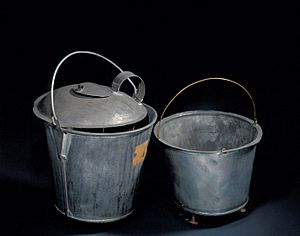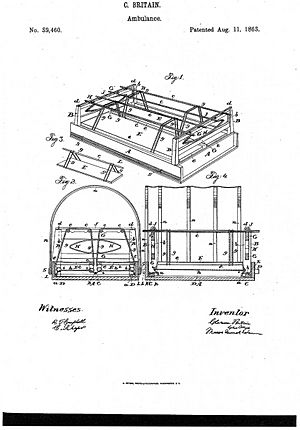Clarissa Britain facts for kids
Clarissa Britain (1816–1895) was an amazing American inventor from the 1800s. She received seven patents in just 18 months, starting in 1863. Before becoming an inventor, she was a school teacher. She even started her own school called Niles Female Seminary in Niles, Michigan.
Early Life and Education
Clarissa was born in Brownville, New York. Her family was well-known and had a good social standing. Her father, Calvin Britain, was a Major-General during the War of 1812. Her brother, also named Calvin Britain, helped found St. Joseph, Michigan. He later became an important politician in Michigan.
Because her family was well-off, Clarissa received a good education. This allowed her to become a teacher. She taught for several years in schools near her home in Brownville. From 1838 to 1839, she attended Emma Willard's Troy Female Seminary. After her time in Troy, Clarissa became an assistant at a seminary school in Washington, Pennsylvania.
This was the start of Clarissa's many travels across the United States. She lived in at least seven different states during her life. This was quite unusual for a woman in her time. Her family's moves were the main reason for her traveling lifestyle.
Teaching Career
In 1841, Clarissa moved to Niles, Michigan. She wanted to be closer to her brother Calvin. She also wanted to start her own school, the Niles Female Seminary. She was the principal there until 1848, when she sold the school. Clarissa then moved back to Troy and taught at Troy Seminary for three years.
Later, she moved to Beaufort, South Carolina, to be near her sister, Martha Johnston. We don't know exactly where she taught in South Carolina. However, it seems she left Beaufort for a while. She spent several years as a vice principal at a school in Wheeling, West Virginia. After that, she returned to Beaufort.
While she was in Beaufort the second time, the Southern states decided to leave the North in 1860. This led to the American Civil War. Clarissa lived only six miles from the Battle of Port Royal in 1861. In 1862, her brother Calvin died. She traveled back to St. Joseph, Michigan, to take care of his affairs. It's not clear how she traveled back to Michigan. She likely came very close to the fighting during the Civil War.
Her Inventions
In 1863, after settling her brother's estate, Clarissa's career changed. She went from teaching to inventing! We don't know why she made this change. Maybe what she saw during her journey north inspired her to create some of her inventions. Or perhaps she was looking for a new way to earn a living.
Whatever the reason, in just a year and a half, Clarissa applied for and received seven patents. One of her patents was for an improved ambulance. This invention was designed to help move wounded soldiers and bodies from battlefields. She also invented several improvements for cooking. Another patent was for a dinner pail for miners (Patent No. US41,274). This special pail included a light, a way to warm food, and eating utensils.
Later Life
After her time as an inventor, Clarissa moved to Kenosha, Wisconsin. She worked as the principal at Kemper Hall for one year in 1866. Then she returned to South Carolina to care for her sister's seven children after their mother passed away. In 1870, she moved to Chicago with the children and their father. She focused on raising her sister's children there.
Clarissa lived in Chicago for several years. Later, she returned to St. Joseph, Michigan, to live with her sister, Isabella. In the 1880 census, she listed her job as a retired teacher.
Clarissa made one more move to Baton Rouge, Louisiana. The reasons for this move are not known. She died in Baton Rouge in 1895 at the age of 80. It seems Clarissa was never able to sell the rights to any of her inventions. Interestingly, her obituary (a notice of her death) never even mentioned her career as an inventor.
Images for kids




